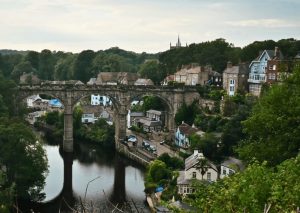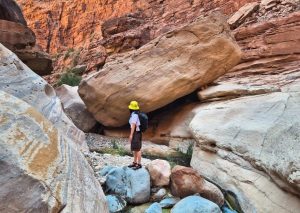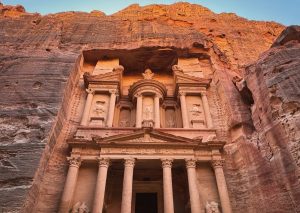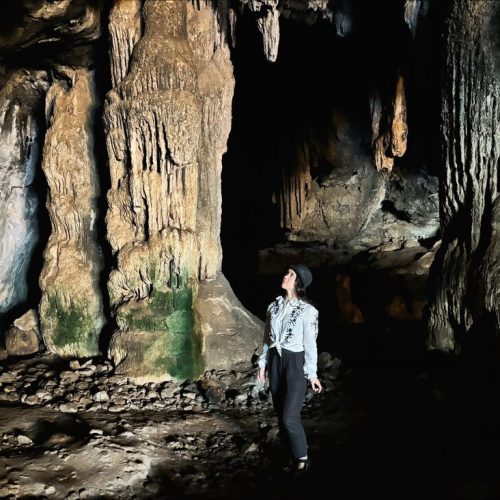Why don’t more people visit Toulouse?
That’s the question I found myself asking as I wandered from one beautiful street to the next. Toulouse, often referred to as “La Ville Rose” or “The Pink City”, more than lives up to its name, dazzling in hues of pink, red, orange and terracotta.

Situated in the southwest of France, Toulouse is the 4th largest city in the country and while known foremost for its picturesque pink facades, it has so much more to offer beyond its captivating colours.
Nestled on the banks of the Garonne River and at the heart of the aerospace industry, Toulouse displays a perfect blend of culture, cuisine, architectural delights and innovation.
Of all the cities I’ve visited in France, Toulouse has so far been my favourite. While it might not be located by the sea or at the foothills of the Alps, it has a wealth of attractions on its doorstep.
In this travel guide I will showcase the city’s top attractions and the nearby towns and cities that you can easily visit by train. A visit to Toulouse opens up endless opportunities to explore Occitania, a region of France that has captured the hearts of many.

Culinary delights in Toulouse
I’m kicking off this guide with the food because we’re in France after all, and the cuisine is big reason why so many people travel far and wide to France.
Toulouse offers some of the best food in the country. I know some people might contest this, but I believe this to be true. Feel free to protest this claim in the comment section – I’m always looking for new regions to satisfy my taste buds 🙂


While France is known all around the world for Haute cuisine, on the flip side you have Provincial cuisine which is all about simplicity and authenticity and this is the type of French cooking that gets my taste buds pumping with blood.
I love hearty food and Toulouse is famous for its cassoulet, a hearty dish made with white beans, sausages, duck confit, and pork. Enjoy this regional specialty at traditional restaurants like Au Gascon popular with locals, or L’Os a Moelle where I demolished the best cassoulet of my life.
Vegetarians need not worry, many restaurants have a good selection of plant-based options. Head to Sixta for a fully vegetarian and vegan menu with an emphasis on organic ingredients.
If you’re dining in a mixed group, I recommend heading to Aux Pieds Sous la Table which has a lovely selection of fresh and innovative dishes that cater for a range of dietary needs.

For a true taste of Toulouse, head to Marché Victor Hugo, the city’s largest and most renowned market. This bustling market is a food lover’s paradise and where local life is at its fullest.
The market offers a wide array of fresh produce, meats, cheeses, and pastries. If the weather is nice, I recommend picking up some ingredients for a picnic by the river.
The friendliest people in France
Above everything else, I believe that Toulouse’s greatest quality can be found in the friendly people – a quality that is said to sometimes evade other French cities.
I’m definitely not the only person who believes this either – a quick browse at polls, and you’ll discover that Toulouse ranks at the top of France’s friendliest cities as voted by French people.


The friendly-factor no doubt adds to the city’s relaxing atmosphere. I’m told by a local that people respect each other and the space they share, and this translates to a sense of community spirit and care towards each other.
As merely a visitor to the city, it was clear to see this through the remarkably clean and well-maintained streets, the enjoyment of public spaces, and the small, fleeting interactions I had with shop owners and restaurant staff.
No tourist traps



To its blessing, you won’t find the typical tourist traps in Toulouse. Yes, it has a wealth of historical and modern attractions, but without the long queues or hoards of tourists. Almost sounds too good to be true, right?
From all around small impressions of local life drift through the streets. The atmosphere is laid-back and offers the charm that so many people love about France and French culture. I can’t tell you how many times I said to myself, ‘I would love to live here.’
In a world that has a habit of churning out soulless chain shops, this isn’t the case in Toulouse. Lots of the shops are independent and specialise in items such as books, musical instruments, hand-made ceramics and regional produce to give a real sense of local identity to the city.
Historical landmarks
Basilica of Saint-Sernin

The Basilica of Saint-Sernin, a UNESCO World Heritage Site, is city’s the most important church, built in honour of St. Sernin, the first bishop of Toulouse.
It’s difficult to wrap your head around the fact that this place of worship is nearly 1000 years old! As a result, you have to appreciate that the interior might not be as lavish as you might find in Gothic churches that were built later. Even today, however, it is one of the largest Romanesque churches in Europe.

The basilica’s structure is symbolically shaped like a crucifix and includes a striking 65m bell tower. As you explore its nooks and crannies, be sure to visit the crypt below which houses holy relics.
Saint-Sernin is a pilgrimage site in its own right for hundreds of centuries, and also an important stop along the the Camino de Santiago, also known as Way of St James. All around Toulouse, you will notice the iconic scallop shell embossed on street corners to indicate that you standing upon a section of this famous pilgrimage route.
Couvent des Jacobins
Another architectural gem is the Church of the Jacobins and the Convent of the Jacobins. I feel they can be seen as separate attractions, so I’ll give you an overview of them separately despite them being part of the same complex.

Church of Jacobins
This Dominican church dates back to the 13th century. Its Gothic architecture, highlighted by the stunning palm-tree-shaped column in the church’s apse, is truly captivating. So elegant, in fact, I think it pips the top spot for the most beautiful landmark in Toulouse (IMO).
In the middle of the church you will find the relics of St. Thomas Aquinas whose remains are entombed in a golden reliquary beside the altar. If you took philosophy or theology at school, chances are that you would’ve heard about this guy. While a Dominican Friar during his life, he is best known for his philosophical teachings, being described by many as, “the most influential thinker of the medieval period.”

Convent of Jacobins
So, the reason I’ve separated the church from the convent is because the church is free to enter, but the convent has an entry fee of 12 Euros.
I preferred the church so if you’re squeezed for time or money, I think you would’ve already seen the best part of the complex. It wouldn’t be a travesty if you skipped the convent. If, however, you have spare time, money, and a penchant for history and medieval architecture, I recommend seeing the convent as well.
The convent’s cloister offers a peaceful retreat, where you can enjoy the tranquil garden and ancient arcades. There is a well appointed museum that includes relics from the Dominican order, as well as a few interactive displays that provide historical information about the priests who travelled to France from Italy to spread the word of their religious teachings.
Address: Pl. des Jacobins, 31000 Toulouse, France
Opening Hours: 10am-6pm Tues-Sun (closed Mon)
Chapelle des Carmelites

This is the last religious site on my list in case you’re wondering! This small but stunningly beautiful chapel is a feast for the eyes.
Chapelle des Carmélites, originally part of a larger Carmelite convent, was built in the early 17th century. It was founded by King Louis XIII and his wife, Anne of Austria, as a gesture of gratitude to the Carmelites for their support during the king during illness.
The chapel was consecrated in 1622 and has since stood as a testament to the enduring legacy of the Carmelite Order in Toulouse. The convent itself was a significant religious and cultural centre until the French Revolution, when it was secularised and unfortunately largely dismantled.

The chapel, however, survived the turmoil of the revolution and subsequent periods of neglect. Eventually it was restored to its former glory after the Minister of Culture took it over in 1975.
When I entered inside chapel I said it reminded me of a mini Sistine Chapel, and lo and behold, the ceiling was painted by Jean-Pierre Rivals who was inspired by the Sistine Chapel. Imitation is the highest form of flattery as they say.
Address: 1 Rue de Périgord, 31000 Toulouse, France
Opening times: 10am – 7pm Wed – Sun (closed Mon & Tue). Entry: Free
Le Capitole

This iconic building dominates Toulouse’s main square and serves as the city hall and the opera house.
The Capitole’s neoclassical façade is painted pink and adorned with eight marble columns. A striking sight at any time, but especially when illuminated at night.
Head inside to marvel at the ornate Salle des Illustres, a grand hall decorated with paintings, murals and sculptures celebrating Toulouse’s rich history. It gets an extra bonus point for being free to enter.
Pont Neuf

Although called “Pont-Neuf” (new bridge), it is ironically the oldest bridge in Toulouse crossing the Garonne river. Built in 16-17th century it is very much part of the Toulouse landscape, being a popular landmark and meeting point. With its seven elegant arches it wouldn’t look out of place in somewhere like Venice.
A quirky feature of the Post Neuf is the Little Red Boy sitting inside the bridge. It was created by artist James Colomina who explores compelling themes such as lonliness, the passing of time, and self-destruction.
A riverfront walk to Port Neuf offers a lovely way to relax and soak up the atmosphere. It seemed to be a particular popular spot with students, who had leisurely gathered in their friendship groups to whittle away the warm, sunny evening.
Green spaces & parks
The Japanese Garden


Well, I wasn’t expecting to find a Japanese Garden in Toulouse! Though the more I think about it, the less it actually seems surprising. Both countries have a strong penchant for manicured-style gardens.
Having been to Kyoto and the ancient city of Koyasan, I had prepared myself for disappointment. As it turns out, I momentarily forgot I was in France. After all, we’re talking about a nation famous for elegance and they nailed it to perfection. It didn’t at all feel like a bad imitation as I feared it might.
The garden features traditional elements such as koi ponds, arched bridged, stone lanterns, and meticulously pruned trees. The serene ambiance makes it an ideal place for a peace and tranquility.
The Japanese garden is ‘hidden’ within the larger Compans-Caffarelli Park which itself is very lovely. Here’s what you call two attractions in one!
Jardin des Plantes

Jardin des Plantes is another delightful green space to lap up the sun in Toulouse. An exploration reveals a variety of manicured gardens, plant species, sculptures, ponds, pedestrian pathways and play areas.
Next door you will also find the Natural History Museum. Had it been a rainy day, I would have visited, but the weather was far too nice to tempt me inside. Next time I’m in Toulouse, it’s on my list of things to do.
Embankment walk of the Garonne River

A stroll down the embarkment of the River Garonne at sunset captures the essence of c’est la belle vie – it’s a beautiful life – something folks here seem to guard like one of their human rights. Sunbathers, cyclists, pic-nic goers and boat riders arrive here to relax and play in equal measure.
Head over before sunset and soak up the serenity of the calm waters, while watching the sky changing colours over the Pink City.
Toulouse is home to several bridges, each with their own architectural features that you might want to see up closer. While Port Neuf is the most famous, the most relaxing are the pedestrian bridges that link green areas of the city together.
Museums & galleries
Cité de l’Espace (Space Museum)

Toulouse has a lot to be proud about, but one of its greatest achievements is becoming Europe’s aerospace powerhouse, earning the title of the European Capital of Space. The city boasts the headquarters of Airbus, the SPOT satellite system, ATR and the Aerospace Valley. Impressive, right?
Visitors can get an insight into the innovative work by visiting the Cité de l’Espace. This interactive museum and science centre invites you to explore the wonders of space through engaging exhibits and hands-on activities.
Inside you can expect to find a range of exciting objects on display. Adults and kids will surely be amazed at an actual chunk of moon rock as well as spectacular full-size rocket models and prototypes.
Visitors can also experience the thrill of a simulated space mission, marvel at life-size replicas of spacecraft and gaze at the stars in the planetarium. This is a place that thinks and dreams big.
Les Abattoirs

Les Abattoirs, a former slaughterhouse turned contemporary art museum, is a cultural hotspot in Toulouse.
The museum showcases a diverse collection of modern and contemporary art, with works by renowned artists such as Pablo Picasso and Henri Matisse.
The surrounding area is also worth exploring. Once considered a gritty part of the city, it has established itself as the hipster part of town, home to a vibrant arts scene, with galleries, theatres, and creative spaces that foster local talent.
Completing the trip, is the adjoining park which is home to a small collection of modern sculptures and a charming vintage carousel.
Day trips from Toulouse
Carcassonne
The medieval city of Carcassonne is the most popular day trip from Toulouse. A crown of 13th-century architecture – towers, turrets and cobblestone alleys appear like the setting of a fairy tale.
Sitting majestically from atop a hill, the historic town is fortified by medieval walls featuring a mighty 52 watchtowers. Needless to say, Carcassonne’s founders were taking no chances with potential threats.
The location of many films including Robin Hood (1991) featuring Kevin Coster, its cinematic beauty earned it UNESCO World Heritage Site status in 1997.
Duration to Carcassonne: 50 minutes by train.
Albi
I can’t overstate the charm of Albi enough – this medieval city and UNESCO World Heritage site should not be missed off any trip to Toulouse. If you only have time for one day trip, Albi gets my vote.
Albi is well-known for its characteristic brick architecture, with the town’s more impressive highlight being its 13th-century cathedral, the largest brick cathedral in the world. While the size is impressive, its the intricate detailing from the stain glass windows to the stone sculptures that add the wow factor.
Albi was also the birthplace of the much beloved French artist Henri-Toulous Lautrec. A museum dedicated to the iconic painter is located within the splendid Palais de la Berbie, another brick architecture masterpiece that is home to a truly immaculate garden.
Duration to Albi: 1 hour by train.
Further reading: Albi – the Perfect Day Trip From Toulouse
Lisle-sur-Tarn
If you love olde-worlde backdrops, the small but idyllic town of Lisle-sur-Tarn offers a worthwhile visit. Just a 20-minute train ride from Albi, it’s easy to combine both of these places in one day.
With narrow cobblestone streets and timber-framed houses, the town is home to some of the cutest timber-framed houses I’ve ever laid my eyes on. Simply potter around and soak up the quieter pace of life.
Duration to Lisle-sur-Tan: 40 minutes by train.
Planning a trip to Toulouse?
To help you plan your trip to Toulouse, whether you are looking for accommodation or pre-bookable attractions, these resources might come in handy.
How to get there: Arriving in Toulouse will vary depending on where you live in the world. For those who plan on flying I recommend looking at the best deals on Skyscanner. Toulouse airport is just a 15-minute drive into the city centre. If you prefer to travel by train, you can prebook tickets via the Trainline. And for those who wish to hire a care, take a look at RentalCars.
Accommodation: Toulouse is surprisingly affordable compared to other many other cities in France. I suggest staying in the historical centre next to the Basilica of Saint-Sernin. However. Toulouse is a very walkable city and you should be able to reach all the main attractions by foot from most locations with ease. To find availability and book hotels I use and recommend Booking.com.
Activities: Looking for walking tours, museum passes, guided day-trips, and more? See what’s on offer in Toulouse with GetYourGuide.









